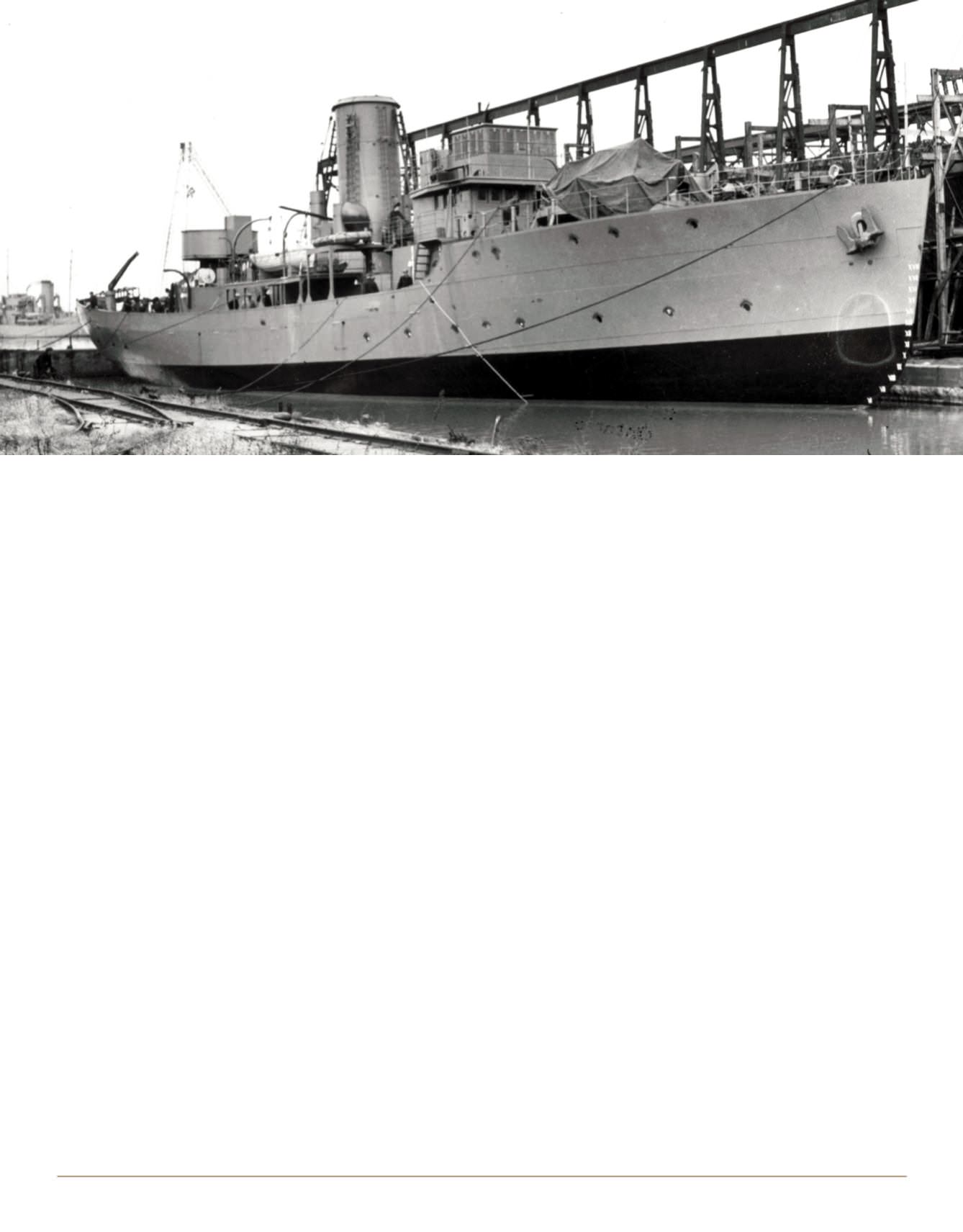
From 1942 to 1944, HMCS Collingwood
was transferred to the “Newfie—Derry run.”
As the tideof thewarwasbeginning to shift in
favour of theallies, convoy escorts no longer
turnedaroundat Icelandbut continued to sail
to theNorth Irish port. This was dangerous,
dirtyworkbutCollingwood finished thewar in
April1945, relativelyunscathedasa training
vessel inHalifax.Shewasde-commissioned in
July1945andsold for scrap,eventuallybeing
torched inHamilton in1950.
Bill Clearihue of theNaval Club of Toronto
provided informationabout a notable recog-
nitionof the ship.
In1984, with the assistance of several area
parents, LauraGroos foundedCollingwood
School, an independent learning centre in
NorthVancouver. Ms.Groos is thedaughter
of DavidGrooswhowas oneof the captains
ofHMCSCollingwood. In1942, theCorvette
was his first command. Itwas under hisdirec-
tion that theshipsuccessfullynavigated theun-
forgiving seasof theNorthAtlantic.
DavidGroos retired in 1961 as aCaptain,
RoyalCanadianNavyaftera longanddistin-
guished career that had started pre-war in
1935.Hewasborn inMilwaukee,Wisconsin,
andwas electedas aMember of Parliament
in the general elections of 1963, 1965and
1968. Inhis final term, hewas theParliamen-
tarySecretary to theMinister ofNational De-
fence. Hediedat the relatively youngageof
57 in1976.
The school’s badge traces its legacy to the
Collingwood family coat of arms andat one
time in thepast, oneof their sports teamswas
named, “TheCorvettes.” Theschooldid,how-
ever,commissionapaintingofHMCSColling-
wood,alldeckedout inherWWII livery.Even-
tually, along with the ships built at
Collingwood, a total of sixty-five Corvettes
werebuilt inotherCanadianshipyards, includ-
ingneighbouringMidland,Ontario.
In his book, “AMilitaryHistory of Canada,”
Professor Desmond Morton describes life
aboardaCorvette, likeHMCSCollingwood.
“Corvettes rolled, inaheavydew. Theyprom-
isedacrampedand sometimeshellishexperi-
ence for their tinycrewsbut theywereall that
waspossible in thecrisis (of theearlywar).”
It was the crew of another Corvette, HMCS
Matapedia, thathelpeddevelopa remedy for
easing the sufferingof countless sailors. John
Rhodes Sturdy, who was a junior officer
aboardMatapediawasquoted inaReader’s
Digest article, “Therewere timeswhen some
doubtexistedas towhichwas thegreatermen-
ace in theBattleof theAtlantic: theenemyor
theheaving innardsofAllied seamen.”
Until1943, seasicknesswasnota recognized
medical condition and therewas no topical
cure for the condition. Matapedia was as-
signed to the same St. John’s—Iceland run as
HMCSCollingwoodandone sailor aboard
herwasa stoker namedMahoney. The sailor
had trieddesperately toget to seaandMata-
pediawas his first ship but tenminutes after
leavingSt. John’s, themanwasviolently ill. His
conditionworsened until it becameapparent
that hecouldnotperformhis job. Thechiefen-
gineer confined Mahoney to his hammock
and the sickmanhad turnedgrayand resem-
bled a barely living cadaver. To compound
the situation, hehadbegun togiveup interest
in living.Hiswasachroniccase.
The captain of theMatapediaRonald J. Her-
manwasa rarity for theRCNat that timeashe
was aprofessional sailor and he quickly as-
sessed the need of his subordinate stoker.
There were no medical doctors aboard
Corvettesandwhen theship finallypulled into
theeastern terminusof theduty,a forlorn fjord
in Iceland, Herman sought medical attention
forMahoney.
TheMatapediahad tiedupalongsideaBritish
depot ship on which were several medical
doctors. Rhodeswas assignedby theCana-
dian ship’s captain to go aboard the depot
shipand obtain a report on the condition of
Mahoney. “I supposeyou’rehereaboutMa-
honey,”grunted theBritmedic. “Well, there’s
nothingwrongwithhim.”
Rhodes struggled tomake a case of chronic
seasickness thathe fearedwouldkill thestoker
but the doctor fumed, “Now, look here, I’ve
examined thechap thoroughlyandexcept for
beinga trifleundernourished,he’s really in tip-
top shape.Heart and lungsare first class.”
Thedoctor refused to removeMahoney from
theCorvette’scomplimentandMahoneywas
packedoff to return tohisship.Off Iceland, the
tiny ship was plummeted by an 80-mile an-
hourgaleand thepoormanbecameso ill that
the captain thought he would die. The ship
racedback toSt. John’swhereMahoney saw
aCanadiandoctorwhoonceagain foundhim
fit for sea duty. The captain was furious be-
causeheknew that hismanwouldnot survive
another voyage so he went up his chain of
commanduntilasympathetic flagofficer,Rear
AdmiralGeorgeC. Jones, listened to thestory
thathadnowbecomemuch larger than just the
oneof StokerMahoney.
☛
HMCSOrilliaafterbeing launchedat thestageof completionat theCollingwoodshipyard.
109
|


